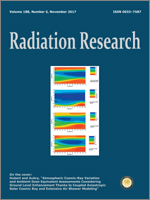Exposure to ionizing radiation alone or combined with traumatic tissue injury is a crucial life-threatening factor in nuclear and radiological incidents. Radiation injuries occur at the molecular, cellular, tissue and systemic levels; their mechanisms, however, remain largely unclear. Exposure to radiation combined with skin wounding, bacterial infection or burns results in greater mortality than radiation exposure alone in dogs, pigs, rats, guinea pigs and mice. In the current study we observed that B6D2F1/J female mice exposed to 60Co gamma-photon radiation followed by 15% total-body-surface-area skin wounds experienced an increment of 25% higher mortality over a 30-day observation period compared to those subjected to radiation alone. Radiation exposure delayed wound healing by approximately 14 days. On day 30 post-injury, bone marrow and ileum in animals from both groups (radiation alone or combined injury) still displayed low cellularity and structural damage. White blood cell counts, e.g., neutrophils, lymphocytes, monocytes, eosinophils, basophils and platelets, still remained very low in surviving irradiated alone animals, whereas only the lymphocyte count was low in surviving combined injury animals. Likewise, in surviving animals from radiation alone and combined injury groups, the RBCs, hemoglobin, hematocrit and platelets remained low. We observed, that animals treated with both pegylated G-CSF (a cytokine for neutrophil maturation and mobilization) and Alxn4100TPO (a thrombopoietin receptor agonist) at 4 h postirradiation, a 95% survival (vehicle: 60%) over the 30-day period, along with mitigated body-weight loss and significantly reduced acute radiation syndrome. In animals that received combined treatment of radiation and injury that received pegylated G-CSF and Alxn4100TPO, survival was increased from 35% to 55%, but did not accelerate wound healing. Hematopoiesis and ileum showed significant improvement in animals from both groups (irradiation alone and combined injury) when treated with pegylated G-CSF and Alxn4100TPO. Treatment with pegylated G-CSF alone increased survival after irradiation alone and combined injury by 33% and 15%, respectively, and further delayed wound healing, but increased WBC, RBC and platelet counts after irradiation alone, and only RBCs and platelets after combined injury. Treatment with Alxn4100TPO alone increased survival after both irradiation alone and combined injury by 4 and 23%, respectively, and delayed wound healing after combined injury, but increased RBCs, hemoglobin concentrations, hematocrit values and platelets after irradiation alone and only platelets after combined injury. Taken together, the results suggest that combined treatment with pegylated G-CSF and Alxn4100TPO is effective for mitigating effects of both radiation alone and in combination with injury.
How to translate text using browser tools
29 August 2017
Combined Therapy of Pegylated G-CSF and Alxn4100TPO Improves Survival and Mitigates Acute Radiation Syndrome after Whole-Body Ionizing Irradiation Alone and Followed by Wound Trauma
Juliann G. Kiang,
Min Zhai,
David L. Bolduc,
Joan T. Smith,
Marsha N. Anderson,
Connie Ho,
Bin Lin,
Suping Jiang
ACCESS THE FULL ARTICLE

Radiation Research
Vol. 188 • No. 5
November 2017
Vol. 188 • No. 5
November 2017




